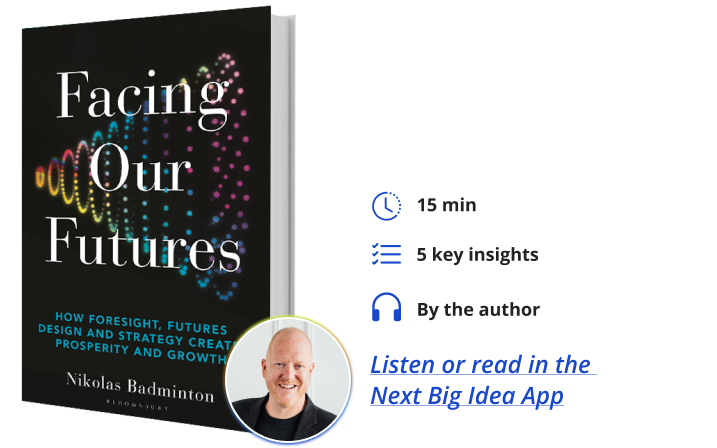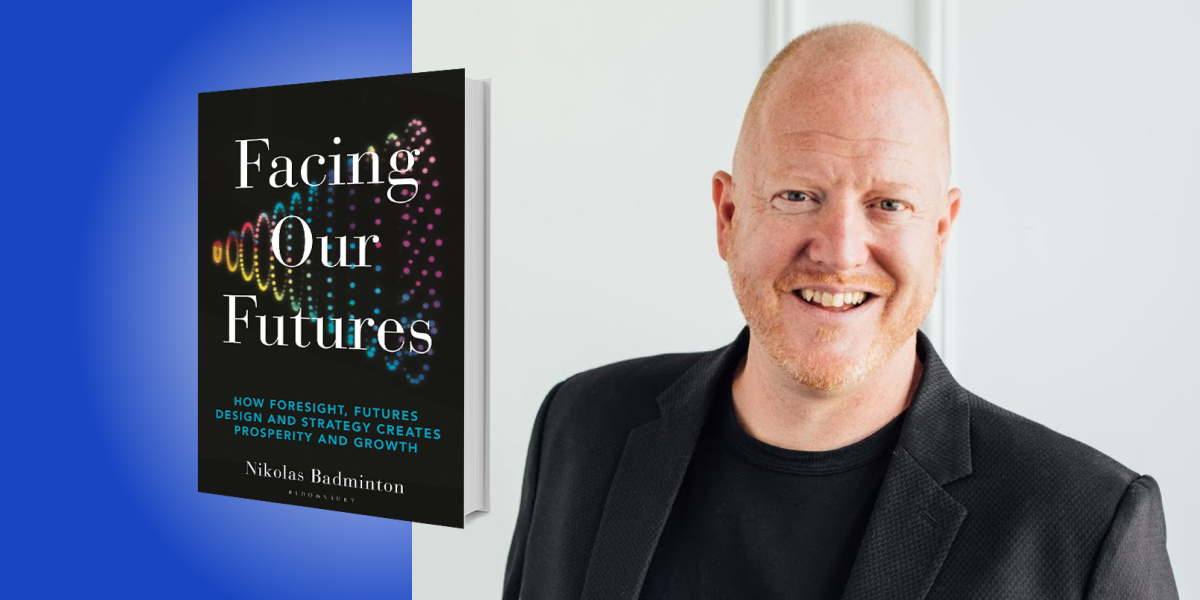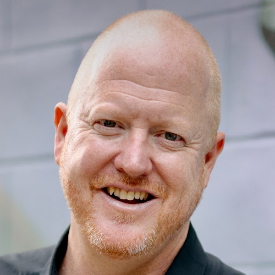Nikolas Badminton is a futurist advisor, speaker and researcher. He is Chief Futurist and Think Tank leader at Futurist.com. Below, he shares five key insights from his new book, Facing Our Futures: How Foresight, Futures, Design, and Strategy Create Prosperity and Growth. Listen to the audio version—read by Nikolas himself—in the Next Big Idea App.

1. Question your own history.
We have to aim to rewrite our assumptions and consider the impact of our personal and organizational agendas. Practice curiosity and be courageous. We really have to share our own true thoughts and lively discussions. We also need to listen carefully to others. We need to get comfortable with ambiguity and multiple perspectives.
Organizations have as many internal futures as employees, multiplied by the number of interactions they have over time—and that’s before we turn to face the world. There are lots of opportunities to explore new perspectives and understand that ambiguity is our friend.
We also must be wildly creative. We have to work fast and write down as many ideas as possible and work them through with our teams. We have to look at the possible and the preposterous, and we can’t discount any solutions presented. We need to discuss them with our groups, our colleagues, consumers, and the general public, and we need to dial it up to 10 when we think about what might come next.
What’s also important is that we focus on the non-zero-sum game. That means that we need to ensure that the futures that we all imagine are places where multiple people win.
2. We must see the plurality of our futures and address the collective poverty of imagination.
There it is, the future. Look at it, glorious, pristine, accessible. It’s yours, but it’s built by us. We are the people, the organization that can corral investors and resources to make it happen. All you need to do is to believe in what we do and it’s possible with resolve and support. But it won’t be easy. We just need to trust in science, technology, and shooting for the moon. We also need several billion dollars and a few years to make this future a reality…
Stop. There’s a big problem with this narrative. The technocrats have taken hold of our world and we have to be real about what’s coming ahead. The billionaire technocrats, politicians, and fervent investors are not looking out for us and our futures. They want to define a closed ecosystem and narrow view that can be easily regulated and policed by the terms and conditions we happily accept so that we are being reduced to just being users. It’s the antithesis of how we as humans and our complex societal structures operate. These are often the same people who think that living to 120 years old, becoming a multi-planet species, and the exponential growth of technological solutions is a bigger goal than being a thriving and sustainable multi-species planet.
We have to carefully respect and consider the relationship between humanity, the natural world, and our industrial complex. We must recognize that there is no singular future and that we must address the collective poverty of imagination. In fact, the majority of organizations actively kill imagination and good ideas that push the boundaries of offerings and operations.
“The billionaire technocrats, politicians, and fervent investors are not looking out for us and our futures.”
Reigniting our imaginations and giving ourselves space to breathe and move is as important to the discipline of strategy and foresight as any of the frameworks that we use. Reigniting our curiosity, activating social dreaming, and encouraging everyone to be open with their thoughts and feelings on multiple futures are essential to the work that we do. There is a huge advantage to seeing many possible futures. Reigniting those imaginations to provide vigilance in organizations is a bedrock and a foundation of a modern organization.
In 2018, Rohrbeck and Kum published a paper called “Corporate Foresight and Its Impact on Firm Performance.” They managed to correlate vigilance and future preparedness with companies that recognize that the future might change the very foundation of their business. Those that prepare for a change in their course of action are 33 percent more profitable than companies on average. These vigilant companies have achieved a 200 percent higher growth rate than the average company. Seeing companies embrace future thinking has motivated thousands of business leaders to wake up and reach out to us to start this work. Think tanks and other foresight practitioners around the world are busier than ever before. The truth is, if we show the opportunity for more profits and growth, it’s still the catalyst for exploration and action.
Today, it’s time for executives, world leaders, and people to shape a path for our world to understand. There is no perfect positive future singular, and our short-term thinking is endemic and dangerous. It’s time to embrace foresight as a discipline that empowers us to look at horizons that lie beyond our short-term cycles of strategic planning. We need to look at 10, 20, 30, and even 100-plus years to create long-term resiliency by considering our decisions and actions today.
3. We have the work of exploring futures.
At the heart of this is explicitly setting out foundational principles, both positive and dystopian. These principles can be provocative and they drive discussion. The balance of both sides of the same future means that we can have a holistic view. When we think about positive principles, we’re trying to aim for a world that addresses the challenges we see day-to-day in a structurally and technologically colonized world.
These principles provide the ability to imagine a trajectory that drives us toward an ideal state for humanity and the natural world. We are going to strive to design futures to achieve this. That means that we have to plan for humanity before technology. We need to design with plurality, inclusion, and equity, and we must go back to the fact that we have science and creativity to fall back on.
On the flip side of that, we’ve got the dystopian principles. These are actually somewhat reflective of the modus operandi of so much of big business that we see today. It’s based on greed, inequality, and collapse. Our dystopian principles provide the ability to imagine a trajectory that drives us to travel towards a state which will be suboptimal for humanity and the natural world. Discussing these principles gets to the heart of what we really want to do in the world. This really helps us lay a foundation to understand how we can move forward through the stages of work in futures exploration.
The first part of this is around signal scanning. We look for distinct pieces of information, statistics, stories, and activities that indicate an impending change or an emerging issue that may become significant in our future. From these signals, we can do trend identification. These are the general directions in which our world is developing or changing. They inherently have momentum and they’re created by existing conditions and environments. They’re going to be part of the reshaping of how we see the world and how we operate within it.
From these signals and trends, we can then start to build out scenarios. The reference points that we have from those signals and trends indicate what might come next. The scenarios explore how people will be affected, building multiple scenarios of many varied groups of people from differing backgrounds and demographics.
“We can go down the rabbit hole into more emotional and visceral explorations of our futures through fiction, filmmaking, and the creation of media and art.”
Beyond scenario building are storytelling, speculative fiction, and experiential futures. That means that we can go down the rabbit hole into more emotional and visceral explorations of our futures through fiction, filmmaking, and the creation of media and art. When we can place ourselves in these futures, we can feel what they’re like.
I use a fictional company called Organization X to illustrate the process. Organization X is an agricultural futures company. They’re looking to build out their vision for resilient and sustainable agriculture in the context of mega-cities, and its associated portfolio of solutions that address agricultural resiliency. That means the water, food, energy, nexus and climate-related challenges, infield agriculture, agri-food systems, local and global food supply chain, and nutrition in relation to communities, health, wellness, and longevity. These are the areas that are most under duress in society today, and we must hold under a magnifying glass and demand transformation alongside progressive and egalitarian solutions.
4. Using stories helps us empathize with our futures.
There’s a quote I love from the esteemed science fiction writer, Octavia E Butler: “Every story I create creates me. I write to create myself.” I write stories with clients so they can place themselves in the futures we explore together. That’s when they can feel the visceral state of affairs, the societal changes, the sense of place, and the experiences of the people. This is really the sharp end of futures work and it’s the epitome of the craft. Thinking of stories that move us beyond scenarios into imaginative realms affords us the opportunity to travel down the rabbit hole into more emotional and visceral explorations of our futures. It’s an invitation to experience the feelings of our futures and it’s hugely important.
When creating stories of our futures, there are a number of things we should consider. Think about metaphors; they can humanize a story, they’re descriptive, and they can inject richness with few words. William Gibson does this well with the iconic opening line in his novel, Neuromancer: “The sky above the port was the color of television tuned to a dead channel”. Very quickly, he gives us an idea of the world that we are living in in that future. We need to also create unusual heroes and many more villains. It’s incredibly important to throw off the boundaries and visions of what heroes are and the tropes that continue their existence. We need to look to queer, less-abled, and low-income people that have a place, rather than characters like Batman and other rugged billionaires with unlimited resources. Again, we must think about positive and dystopian situations and effects. Positive futures are great, but the hidden systems are where bad actions and actors can exist.
If we write scenarios and stories, work to consider the opposites of the outcomes, then make them worse—more death, more despair, more impact on the people who are less able to react—things then become a lot more visceral and real and the imagery becomes more potent.
We also need to consider what mundane systems surround our worlds and weave them into the stories as well. Futures are not always realities of abundance and unlimited abilities. Think about the mundane systems and situations and dull job descriptions. Waste management, water usage, newspapers, cleaners, accountants, and even futurists. We also need to speak the story with bravery to the people who will agree, and most importantly, to those who will not. We must be willing to argue for the futures that we see ahead of us and for the futures that we all collectively will share together.
5. Futures work is essential for impactful organizations.
Futures work is not a side task. It’s a core competence that will separate those companies that will thrive in the long term from those that will not. Organizations need a senior executive who’s the arbiter of futures discussions within the organizations. A chief futurist is a person that works at the board level to influence company direction, determine decisions and engage external expertise to supercharge thinking within that organization.
“Organizations need a senior executive who’s the arbiter of futures discussions within the organizations.”
Beyond the role of a chief futurist, you have to develop futures consciousness as a capability in the hearts and minds of everyone that drives the organization forward. This is a deeply spiritual practice in many ways, as highlighted in Thomas Lombardo’s work around futures consciousness. He says that there are a number of things that are important. We have to be self-aware, have self-control, and have a sense of self-responsibility. We have to have a sense of realistic idealism, the belief in and the pursuit of excellence. We need self-growth and a progressive personal narrative. We need to have the skill and love of learning, including honesty, wonder, curiosity, humility, and the quest for truth and understanding.
We also have to have the skill and love for thinking and multiple worlds of understanding. We also need to have an expansive temporal consciousness. An expansive temporal consciousness is a rich and thoughtful integration of history and the future, it’s imaginative and visionary and it’s based on good foresight work. We also need to extend that into cosmic consciousness, including all ecological global consciousness and a sense of reciprocity, justice, and transcendence. We need to have hope, courage, and optimism, and we must have love. We must be willing to include gratitude, passionate appreciation, and compassion in our work. We also need to have deep purpose and tenacity and ethical pragmatism, creativity, and an adventurism spirit. Finally, we need to even things out with balance and temperance.
This all seems quite complicated and complex, but the work of futures is deep and ongoing. In the context of all of the great thinkers who have tried to question how we frame futures, and how we push things forward, this is just the beginning.
To listen to the audio version read by author Nikolas Badminton, download the Next Big Idea App today:
































